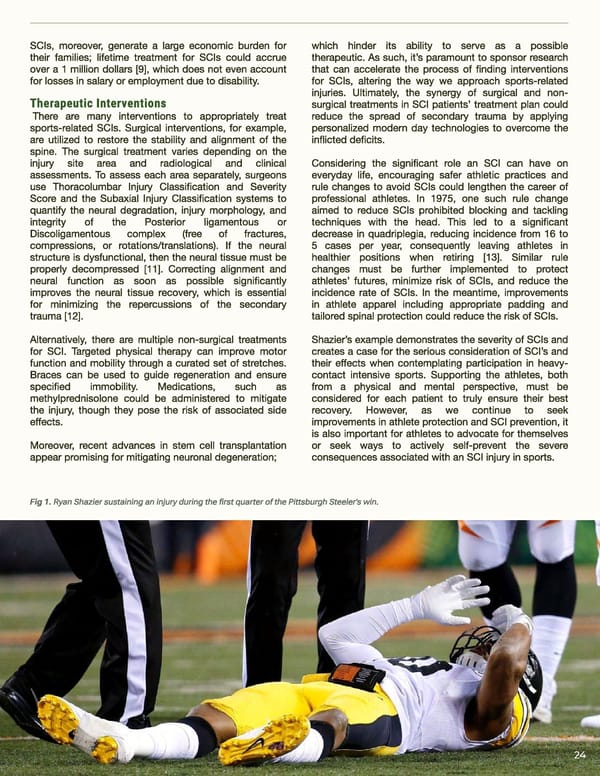SCIs, moreover, generate a large economic burden for which hinder its ability to serve as a possible their families; lifetime treatment for SCIs could accrue therapeutic. As such, it’s paramount to sponsor research over a 1 million dollars [9], which does not even account that can accelerate the process of 昀椀nding interventions for losses in salary or employment due to disability㠀᐀ for SCIs, altering the way we approach sports-related injuries. Ultimately, the synergy of surgical and non- Therapeutic Interventions surgical treatments in SCI patients’ treatment plan could There are many interventions to appropriately treat reduce the spread of secondary trauma by applying sports-related SCIs. Surgical interventions, for example, personalized modern day technologies to overcome the are utilized to restore the stability and alignment of the in昀氀icted de昀椀cits㠀 spine. The surgical treatment varies depending on the injury site area and radiological and clinical Considering the signi昀椀cant role an SCI can have on assessments. To assess each area separately, surgeons everyday life, encouraging safer athletic practices and use Thoracolumbar Injury Classi昀椀cation and Severity rule changes to avoid SCIs could lengthen the career of Score and the Subaxial Injury Classi昀椀cation systems to professional athletes. In 1975, one such rule change quantify the neural degradation, injury morphology, and aimed to reduce SCIs prohibited blocking and tackling integrity of the Posterior ligamentous or techniques with the head. This led to a signi昀椀cant Discoligamentous complex (free of fractures, decrease in quadriplegia, reducing incidence from 16 to compressions, or rotations/translations). If the neural 5 cases per year, consequently leaving athletes in structure is dysfunctional, then the neural tissue must be healthier positions when retiring [13]. Similar rule properly decompressed [11]. Correcting alignment and changes must be further implemented to protect neural function as soon as possible signi昀椀cantly athletes’ futures, minimize risk of SCIs, and reduce the improves the neural tissue recovery, which is essential incidence rate of SCIs. In the meantime, improvements for minimizing the repercussions of the secondary in athlete apparel including appropriate padding and trauma [12]㠀 tailored spinal protection could reduce the risk of SCIs㠀 Alternatively, there are multiple non-surgical treatments Shazier’s example demonstrates the severity of SCIs and for SCI. Targeted physical therapy can improve motor creates a case for the serious consideration of SCI’s and function and mobility through a curated set of stretches. their e昀昀ects when contemplating participation in heavy- Braces can be used to guide regeneration and ensure contact intensive sports. Supporting the athletes, both speci昀椀ed immobility. Medications, such as from a physical and mental perspective, must be methylprednisolone could be administered to mitigate considered for each patient to truly ensure their best the injury, though they pose the risk of associated side recovery. However, as we continue to seek e昀昀ects㠀 improvements in athlete protection and SCI prevention, it is also important for athletes to advocate for themselves Moreover, recent advances in stem cell transplantation or seek ways to actively self-prevent the severe appear promising for mitigating neuronal degeneration; consequences associated with an SCI injury in sports㠀 Fig 1. Ryan Shazier sustaining an injury during the 昀椀rst quarter of the Pittsburgh Steeler's win. 24
 Penn Healthcare Review Fall 2023 Journal— Sports Medicine Page 28 Page 30
Penn Healthcare Review Fall 2023 Journal— Sports Medicine Page 28 Page 30